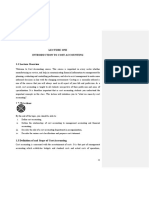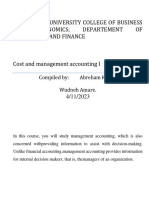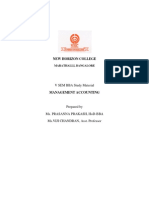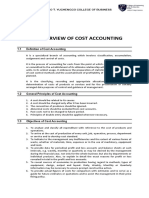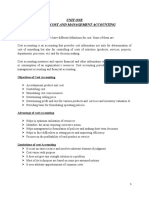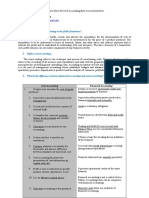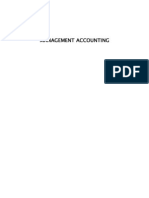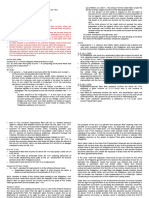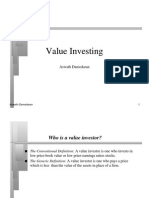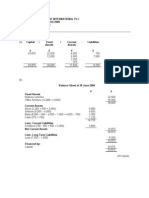1 Chapter 1&2 Cost & MGT Accounting
1 Chapter 1&2 Cost & MGT Accounting
Uploaded by
Minaw BelayCopyright:
Available Formats
1 Chapter 1&2 Cost & MGT Accounting
1 Chapter 1&2 Cost & MGT Accounting
Uploaded by
Minaw BelayOriginal Description:
Original Title
Copyright
Available Formats
Share this document
Did you find this document useful?
Is this content inappropriate?
Copyright:
Available Formats
1 Chapter 1&2 Cost & MGT Accounting
1 Chapter 1&2 Cost & MGT Accounting
Uploaded by
Minaw BelayCopyright:
Available Formats
CHAPTER 1: COST AND MANAGEMENT ACCOUNTING FUNDAMENTALS
1.1 Introduction to cost and management accounting
Management accounting can be defined as the process of identification, measurement,
accumulation, analysis, preparation, and communication of financial as well as non financial
information used by management to plan, evaluate, control within the organization and to assure
appropriate use by and accountability for its resources.
The management accounting is expected to provide timely, accurate information including
budgets standards costs, variance analysis, support day-to- day operating decisions, and analyses of
expenditures. The management accounting consists of accounting techniques and procedures of
gathering and reporting financial, production and distribution data in order to meet management’s
information needs.
The Roles of Management Accounting
The management accounting measures and reports financial information as well as other type
information that assists managers in fulfilling the goals of the organization. The following are some
of the purposes of management accounting
Formulating over all strategies and long range plans
Resource allocation decision such as product and customer emphasis pricing
Cost planning and cost control of operations and activities
Performance measurement and evaluation.
Financial and management accounting
Financial accounting includes all the principle that regulates the accounting for and reporting for
financial information that must be disclosed to people outside the company, to stockholders, bankers
creditors and brokers. In contrast management accounting exists primarily for the benefit of those
inside the company, the people who are responsible for its operations.
Many of the procedures and principles that stem from financial accounting also apply to management
accounting. Depreciation techniques, cash collection and disbursement procedures, inventory
valuation methods and the recognition of what is an asset or a liability are all essential to the study of
management accounting. But, because their output is communicated to different audiences for
different reasons, financial accountants and management accountants follow different rules of
management are somewhat less defined and place fewer place fewer restrictions on the accountant’s
day-to-day activities.
COMPARISON OF FINANCIAL AND MANAGEMENT ACCOUNTING
Area of comparison Financial accounting Management accounting
1. primary users of Persons and organizations Various levels of internal management
information out side the entity
2. types of accounting Double entry system Not restricted to double entry system can be used
system
3.unit of measurement Historical cost (past) Any useful monetary (historical & future)or
dollar physical measure such as machine hours, labor
hours etc.
4. focal point for analysis Business entity as a whole Various segments of a business entity
5.frequency of reporting periodical on a regular When ever needed; may not be on a regular basis
bases
6. degree of objectivity Demands objectivity Heavily subjective for planning purposes, but
historical in nature objective data are used when relevant; future in
nature
7.restrictive guidelines Adherence to GAAP No formal guidelines or restriction only criteria is
useful
Cost and Management Accounting I Chapter 1&2 Hand Out Page 1 of 12
ORGANIZATION STRUCTURE AND MANAGEMENT ACCOUNTING
The management accountant provides a staff function which gives advice and assistance to line
managements. The accounting or finance department in an organization is lead by a finance officer. A
financial officer is a senior officer empowerment with overseeing the financial operation of an
organization. If the organization is large enough; the financial officer can be supported by two
officers called a controller and treasurer.
A controller is responsible for preparing information and report used by both internal users and
external users, where as a treasurer is responsible for activities which are related to money. The
following table shows some the responsibilities of a controller and treasurer.
Controller Treasurer
Supervise the accounting department Identify capital needs and search for a source
Prepare a financial statement both for insiders Managers investment
and outsiders
Budget and variance analysis Short term finance
Tax planning Maintain custody of cash and other asset
Data processing
Cost accounting Responsible for credit policy and collection of
account
Functions of Management Accounting
Management accounting performs three functions
1. score keeping function: accumulating data reporting reliable result to all levels of the
management
recording sales, purchase and payroll system
preparing financial report
preparing depreciation schedule
2. Attention directing function: making visible both opportunities and problems on which
managers need to focus.
o Highlighting rapidly growing market
o Variance analysis and interpretation
o Explaining performance report
3. problem solving functions comparing and analysis to identify the best alternatives in relation
to the organizations objectives
Make or buy decision
Add or drop decision
Sell at split off or process further decision
Cost Accounting
Cost accounting is the process of accumulating cost of manufacturing and other functional process
and identifying these costs with unit produced or some other object. It measures and reports financial
and other information related to the organization’s acquisition or consumption of resource.
-Cost accounting is applied in any type of organization but primarily applied in manufacturing
organization that combine and process raw material in to finished product.
-cost accounting provides information for both management accounting and financial accounting. It is
a subfield of managerial accounting that interfaces with both managerial and financial accounting.
Cost and Management Accounting I Chapter 1&2 Hand Out Page 2 of 12
CHAPTER 2
COST TERMINOLOGE AND CLASSIFICATION
Overview of the chapter
Chapter2 introduces as a general concept and important cost terms. Cost objectives, direct costs and
indirect costs are defined and illustrated. The concepts of cost tracing and cost allocation are
introduced. Cost driver is defined and the relationships of cost driver, variable costs, and fixed costs
are explained. Several approaches are provided to illustrate the concept of cost behavior. Major
assumptions under underlying the definitions of variable and fixed costs are given and the relevant
range is defined. Uses and limitations of unit costs are explained.
Manufacturing firm and their related manufacturing cost categories are introduced. Prime and
conversion costs are defined and explained
The financial statements for service, merchandising and manufacturing sector companies are
compared with the cost of goods sold section being explained and illustrated in detail. Then costs as
assets and expenses are discussed. The three types of inventory appearing on a manufacturer’s
balance sheet are defined. The chapter concludes with a discussion of different meaning of product
cost
Cost terminology
Many accounting reports contain several cost terminologies. A good understanding of the different
cost terminology is essential at least for the following two reasons.
It enables accounting information users to best use the information provided
Uses of common terminology avoids confusion and misunderstanding
The following are some of the terms used in cost accounting.
Cost, expense, loss: Accountants usually define cost as resources scarified or forgone to achieve a
specific objective it refers to disbursement or expenditure of money to acquire goods and services in
the course of generating revenue. For instance purchase of raw martial represent a cost as the raw
material used to produce finished goods that generate revenue when sold.
How ever some disbursements are not costs. For example, the payment of dividend is disbursement
but it does not help to generating revenue, hence it is not a cost.
All cost initially represents an asset. As the asset is used in generating revenue, the amount consumed
becomes an expense. There for expense is expired cost the cost of asset used should then be
recognized as expense to properly match revenue and expenses in the process of determining the
income of the organization over a given period. For instance insurance premium paid in advance to
serve the coming period are initially recognize as asset but as time pass on, the asset is continually
converted in to an expense. Another example may be motor vehicle bought for uses for the coming
five year is an asset when initially purchased. However as the asset is used up in the process of
generating revenue, the cost gradually become an expense. Thus, expenses are expired costs or costs
used up in the course of generating revenue.
Sometimes a firm may incur a cost that produces neither immediate nor future benefit. This is called
a loss.
Cost object: is any thing for which a separate measurement of costs is desired. To guide their
decisions, managers want to know how much a particular thing (such as a product, machine, service,
or process) costs.
E.g. Product, service, project, customer, brand category, activity department etc
Cost accumulation and cost assignment: a costing system typically account for costs in two basic
stages, accoumulation followed by assignment.
Cost accumulation- is the collection of cost data in some organized way by means of an accounting
system.
Cost and Management Accounting I Chapter 1&2 Hand Out Page 3 of 12
E.g. an organization that manufactures consumer commodities accumulates the costs Incurred in
producing the commodities.
Cost assignment- is a general term that encompasses both (1) tracing accumulated costs to direct
relationship to a cost object, and (2) allocating accumulated costs that have a indirect relation ship to
a cost object.
Cost driver: is any factor that affects total cost. That affects total cost. That is change in the cost
driver will cause a change in the level of the cost of a related cost object. Examples:
Mile driven for transport cost
Length of time of call for telephone cost
Meter cub of water consumed for water cost
Unit soled for cost of goods sold
Cost management: is the set of action that a manager takes to satisfy customers while continuously
reducing and controlling cost. Cost reduction efforts frequently focus on two key areas
Doing only value added activities, that is those activities that customers perceive as adding
value to the product or service they purchase
Efficiently managing the use of the cost drivers in the value added activities.
Classification of cost
Cost may be classified in different ways from different point of view. The same cost may be included
in several or in all of the following classification
1. Time period point of view
From time period point of view costs are classified in to historical cost and budgeted cost historical
costs are costs incurred in the past period where as budgeted costs are costs expected to be incurred in
the future period.
E.g. the 8,000 br cost of a computer acquired in 2005 is historical cost in the financial statement of
2006. How ever the 10,000 br cost to acquire a new computer in 2007 to replace the existing one is a
future cost
2. Management function point of view
From management function point of view costs are classified in to:
Manufacturing cost: includes costs from the acquisition of raw material through production until the
product can be turned over to the marketing division to be sold. (eg material, labor and manufacturing
overhead).
Selling cost: are costs associated with marketing and selling a product. They include all costs
included by the marketing division from the time the manufacturing process is completed until the
product is delivered to customers. These costs include advertising, promotion, transportation and
ware house.
Administrative cost: are costs associated with the management of the company and include
expenditures for accounting, legal and administrative activities. Both selling and administrative costs
are non manufacturing cost.
3. Business function (value chain) point of view
Value chain refers to the sequence of business functions in which usefulness is added to the product
or service of a company.
From business function point of view cost is classified as follows:
- Research and development cost -Distribution cost
- Product design cost -Consumer service cost
- Production cost marketing cost
Cost and Management Accounting I Chapter 1&2 Hand Out Page 4 of 12
4. Generally accepted accounting treatment point of view
The alternatives in accounting for cost are to expense it or to capitalize it. Costs that are expensed in
the period in which they are incurred are called non capitalized cost or period cost. These costs
possess no future benefit and are generally associated with a non manufacturing cost.
Period costs (non inventor able cost) - are all costs in the income statement other than cost of goods
sold. These costs are treated as expenses of the period in which they are incurred because they are
presumed not to benefit future periods (or because there is not sufficient evidence to conclude that
such benefit exists).These costs are identified with the period of time in which they are incurred. As
such, period costs are not included as part of the cost of either purchased or manufactured goods.
For manufacturing sector companies, period costs include all non manufacturing costs.
For merchandising companies, period costs include all costs not related to the cost of goods
purchased for resale in their same form.
For service-sector companies, since there is no inventor able cost, all their costs are period costs.
Some examples of period costs are- research and development costs, Selling /marketing/ and
administrative expenses such as salary expense, advertising expenses, sales commission expenses,
depreciation expenses, supplies expense, interest expenses, and the like.
-Where as capital costs include to manufacturing a product (product cost) or to acquire long
term assets. These costs are recorded as an asset at the beginning of and expensed periodically.
These product cost is also called inventorable cost
Product or inventor able costs-are all cost of a product that are regarded as an asset when they are
incurred and then become cost of goods sold when the product is sold. For manufacturing sector
companies, all manufacturing costs are inventor able. Costs incurred for direct material, direct
manufacturing labor, and indirect manufacturing costs create new assets, first work-in process, and
then finished goods.
For merchandizing sector companies, inventor able cost are the costs of purchasing the goods that
are resold in their same form. These costs are the costs of the goods themselves and any incoming
freight costs for those goods. For service sector companies, since there is no inventory of services,
there are no inventor able costs.
5. Cost assignment point of view
From this point of view costs are classified as direct cost and indirect cost
Direct cost - are related to the particular cost object and can be traced to it in an economically
feasible (cost-effective) way. These are direct material E.g.-The cost of office supplies used in the
loan department is a direct cost of that department.
And direct labor E.g. -The salary of a manager of production department is a direct cost of that
department
The term cost- tracing is, therefore, used to describe the assignment of direct costs to the particular
cost object
Indirect cost -are related to the particular cost object but, can not be traced to it in an economically
feasible (cost-effective) way.
E.g. - Cost of quality-control personnel who conduct taste and content tests on multiple soft drink
products bottled at a Pepsi plant is an indirect cost of Pepsi soft drink.
-The cost of general advertising by the bank, which is allocated to the loan department.
The term cost allocation is, therefore, used to describe the assignment of indirect costs to the
particular cost object.
Some of indirect costs are: cost of electricity, depreciation of equipment, indirect labor indirect
material, cost of different utilities, cost of repair and maintenance insurance for the plant
Cost and Management Accounting I Chapter 1&2 Hand Out Page 5 of 12
6. Decision Making Point of View
A Decision involves making a choice among alternative courses of action
From decision making point of view costs are divided as relevant and irrelevant costs
Relevant cost: cost useful for decision making and it is a future cost which change among alternative
course of actions.
Irrelevant costs: are costs not useful for decision making, it is past or sunk which was already
incurred.
Sunk costs- are costs that have been incurred in the past. Consequently, they do not affect future
costs and cannot be changed by any current or future action. Examples of such costs include the
acquisition cost of equipment previously purchased, the manufacturing cost of inventory on hand, and
the like.
7. Management Influence Point of View
Management influence refers to the ability of a manager to control particular cost. Under this point of
view costs are classified as controllable and uncontrollable.
If a manager can control or heavily influence the level of a cost, then that cost is classified as a
controllable cost of that manager.
Costs that a manager cannot influence significantly are classified as uncontrollable costs of that
manager.
Controllability of accost depends on the level of management and time period.
All costs are controllable by some one at some level in the organization if the period is longer
enough.
8. Cost Behavior Point of View
From their behavior point of view, costs are divided in to fixed cost and variable cost
Variable costs-are costs that vary in total, in direct proportion to changes in the level of activity or
cost driver i.e. if activity increase by n%, total variable cost also increase by n%, but the per unit
cost remains constant.
‘‘Activity’’can be expressed in many ways, such as units produced, units sold or purchased, miles
driven, hours worked, and so forth.
E.g. Direct material cost, direct labor cost, commission paid to sales personnel (at Br.30 per
commodity sold), cost of natural gas to heat factory, wages paid to employees who assemble the
goods in the assembly department.
Fixed costs-are costs that remain unchanged in total regardless of variation in the level of activity (or
cost driver), for a given relevant range. If activity increases or decreases by n% within the given
relevant range, total fixed cost remains the same; but the per unit fixed cost changes.
E.g. Salary of plant manager, monthly rental cost of equipment and /or house, depreciation of
machines used to produce furniture’s at Br.10,000 per year and the like.
Total cost is sum of variable cost and fixed cost: (TC=TFC+TVC)
Average cost = Total cost
No. unit produced
Example 1 Student association has hired a musical group for graduation party. The fixed cost of
hiring a band for the party is br. 4,000. The hall in which the graduation ceremony is celebrated can
afford up to 2,000 attendee. It has been determined that the cost of refreshment consumed by each
person attending the party will be br 8.
Cost and Management Accounting I Chapter 1&2 Hand Out Page 6 of 12
Required: A) fill the following table based on the information provided
No. of attendee Total fixed Average fixed Total variable Total cost Total
cost cost cost average cost
500
1,000
1,500
2,000
B) Draw the graph of FC, VC, and TC D) what happen to the fixed cost if the no. of
C) Draw the of AFC, AVC, and TFC Attendee is 3, 000, 5, 000, 7,000
9. Commitment to cost expenditure
Commitment to cost expenditure focused on fixed cost as opposed to variable cost and budgeted cost
as opposed to historical cost
Budgeted fixed cost can be classified as committed cost and discretionary cost.
Committed cost: is one that is an inevitable consequence of a previous commitment.
E.g. Property tax on ware house budgeted for the coming year is an example of commitment cost
because it results from decision to construct the ware house last time
Discretionary cost (programmed or management cost): is one in which the amount of time of
incurrence is a matter of choice. These are non recurring costs for which a finale commitment has not
yet been made and that can be postponed to future period or canceled entirely.
10. Other cost classification
In addition to accounting cost classifications, such as product costs and period costs, managerial
accountants also employ economic concepts in classifying costs. Such concepts are often useful in
helping accountants decide what cost information is relevant to the decisions faced by the
organization’s managers. Some of the most important economic cost concepts are:
Opportunity costs
Out-of- pocket costs
Sunk costs
Differential costs
Marginal costs and Average costs
Opportunity costs-An opportunity cost is defined as the benefit that is sacrificed when the choice of
one action precludes taking an alternative course of action. e.g. if beef and fish are the available
choices for dinner, the opportunity cost of eating beef is the forgone pleasure associated with eating
fish.
Out-of pocket costs- are those that require the payment of cash or other assets as a result of their
incurrence. The out of pocket costs associated with office equipment order is consists of the
manufacturing costs required to produce the equipments.
Differential costs- A differential cost is the amount by which the cost differs under two alternative
actions. It is also known as incremental costs. Suppose for example that Alemaya University is
considering two alternative means of providing accommodation for academic stuffs.
i) To provide a house and transport allowance and get the stuffs reside else where out side the
University compound. Assume that the total monthly cost to be incurred by the university
under this alternative is Br 150,000
ii) To provide all stuff with accommodation within the university compound and pay no house
and transport allowances. Let say that the total monthly cost to be incurred by the university
under this alternative is estimated to be Br 100,000
Cost and Management Accounting I Chapter 1&2 Hand Out Page 7 of 12
The monthly differential cost of accommodating the stuff by the university would therefore be:
Cost of providing house and transport allowance Br 150,000
Cost of accommodating the stuff in the university compound 100,000
Monthly differentia cost 50,000
Marginal costs and Average costs- marginal cost is the extra cost incurred when one additional unit
produced. The additional cost incurred to assemble one additional machinery by assembly department
is the marginal cost of assembling the machinery. The average cost per unit is the total cost for
whatever quantity is manufactured, divided by the number of units manufactured.
NB Many deferent cost concepts have been explored in this chapter. An important task of the
managerial accountant is to determine which of these cost concepts is most appropriate in each
situation. The accountant attempts to structure the organization’s accounting information system to
record data that will be useful for different purposes. The benefits of measuring and classifying costs
in a particular way are realized through the improvements in planning, control, decision making
and other management activities that the information facilitates.
Another important task of the managerial accountant is to weigh the benefits of providing
information against the costs of generating, communicating, and using that information. Moreover the
management accountants are expected to decide on amount of information to be provided. This is
because, to process more information may lead to information overload, the case where managers
face a problem of properly identifying important facts out of what is available.
MANUFACTURING COST
Manufacturing –sector companies purchase materials and components and convert them in to
different finished goods. They typically have one or more of the following three types of inventories:
1. Direct material inventory-direct materials and in stock and awaiting use in the manufacturing
process.
2. Work-in-process inventory-Goods partially worked on but not yet fully completed. They are
also called Work-in-progress.
3. Finished goods inventory- Goods fully completed but not yet sold.
Merchandising-sector companies purchases and then sell tangible products with out changing their
basic form.
They hold only one type of inventory, which are the products in their original purchased form.
Service-sector companies provide only services or intangible products to their customers and hence
do not hold inventories of tangible products for sale.
In manufacturing company production costs are grouped in to three categories these are direct
material, direct labor and manufacturing overhead cost. See the diagram below.
Prime costs and Conversion costs-These two terms are used in manufacturing companies. Prime
costs are all direct manufacturing costs i.e. the combination of direct material and direct
manufacturing labor costs. Conversion costs are all manufacturing costs other than direct material
costs. It is the combination of manufacturing labor costs and manufacturing overhead costs.
These costs are incurred to transform direct materials into finished goods.
Cost and Management Accounting I Chapter 1&2 Hand Out Page 8 of 12
So, prime cost = direct material + direct labor
Conversion cost = direct labor + manufacturing overhead cost
Financial Statement for Manufacturing Company
In order to prepare financial statement for manufacturing company, the following schedules are
necessary.
Schedule 1 Direct Material Cost Used
Direct Material beginning --------------------------------XX
Direct material purchase ----------------------------------XX
Direct material available for use-------------------------XX
Direct material ending ----------------------------------- (XX)
Direct material cost used ---------------------------------XX
Schedule 2 Cost of Goods Manufacture
Direct material cost used ----------------------------------XX
Direct labor cost --------------------------------------------XX
Manufacturing over head cost ----------------------------XX
Cost incurred in current period --------------------------XX
Work in process beginning -------------------------------XX
Total cost incurred to date -------------------------------XX
Work in process ending --------------------------------- (XX)
Cost of goods manufactured -----------------------------XX
Cost and Management Accounting I Chapter 1&2 Hand Out Page 9 of 12
Schedule 3 Cost of good sold
Finished goods inventory --------------------------------XX
Cost of goods manufactured -----------------------------XX
Cost of goods available for sale ---------------------------XX
Finished goods ending ----------------------------------- (XX)
Cost of good sold ------------------------------------------XX
Schedule 4 Income statement for manufacturing company
Revenue ------------------------------------------------XX
Cost of good sold --------------------------------------XX
Gross profit----------------------------------------------XX
Operating expense ------------------------------------ (XX)
Operating income ---------------------------------------XX
Example 2: consider the following account balance for ABC manufacturing company in the year
2004
Beginning balance End balance
Direct material inventory-----------22,000 -----------------------------------------26,000
WIP inventory------------------------21,000 -----------------------------------------20,000
Finished goods inventory-----------18,000------------------------------------------23,000
Purchase of direct material-------------------------------------------------- --------75,000
Direct labor cost -------------------------------------------------------------------- 25,000
Indirect labor cost1----------------------------------------------------------------------5,000
Plant insurance --------------------------------------------------------------------------9,000
Depreciation plant building and equipment -----------------------------------------11,000
Repair and maintenance ---------------------------------------------------------------- 4,000
Marketing, distribution and customer service cost ---------------------------------93,000
General and administrative cost -------------------------------------------------------29,000
Required:
a) Calculate cost of direct material used
b) Calculate cost of goods manufactured
c) Calculate cost of goods sold
d) If revenue for the year is Br. 300,000, prepare income statement for the company.
Example 3: a fire destroyed XYZ manufacturing company completely on January 29,2004.
Fortunately certain accounting records were kept in another building. It revealed the following for the
period from January 1, 2004 to January 29, 2004.
Direct material purchased -----------------------------160,000
WIP January1-------------------------------------------34,000
Direct material January1, 2004 ------------------------16,000
Finished goods January 1, 2004------------------------30,000
MOH cost -----------------------------------------------40%of conversion cost
Revenue --------------------------------------------------500,000
Direct labor cost-------------------------------------------180,000
Prime cost -------------------------------------------------294,000
Gross profit based on sales--------------------------------20%
Cost of goods available-------------------------------------450,000
Requirement:
a) Direct material destroyed
b) Cost of goods manufacturing
c) Finished goods destroyed
d) WIP destroyed
Cost and Management Accounting I Chapter 1&2 Hand Out Page 10 of 12
Individual Assignment-I for Chapter 2
Q1. Ato Alemu was graduated from Teferi Mekonnen school ten year ago. He was working in ABC
Company for the last seven years under different positions. 15 months ago he started his own furniture
factory called JIMER office and house holed furniture. After 3 months since he started operation, he
learned that maintaining an accounting record is essential. He thought he know how to establish an
accounting system, maintain an accounting record and prepare financial statement at the end of the
current year Sene 30, 1998
JIMER office and house holed furniture.
Income statement
For the year ended Sene 30, 1998
Sales Br135,000
Cost of goods sold
Beginning inventory
Direct material 9,000
Work in process 3,000
Finished good 12,000
Direct material purchase 30,000
Direct labor 45,000
Rent 14,000
Light ,heat, and power 5,000
Telephone 1,500
Depreciation 4,000
Indirect labor 6,000
Marketing and administrative 9,000
Insurance 8,000
Miscellaneous MOH cost 2,000
Miscellaneous marketing & adm. 1,800
Total 143,100
Net loss 8,100
The following additional information is available
The ending inventory of direct material, work in process and finished goods is birr 3,000,4500and 15,000
respectively. The following costs should be allocated
Manufacturing Periodic
Rent 60% 40%
Light, heat and power 70% 30%
Insurance 60% 40%
Telephone 70% 30%
Insurance depreciation 80% 20%
He worried why the loss comes; he doubted his capacity of accountancy, and asked you to help him
prepare the income statement as new. (Assignment)
Q2. Supply the missing data for each of the following companies
A B C D
Unit produced 45,000 unit 60,000 unit K 75,000 unit
Total cost E $450,000 $240,000 N
Fixed cost 157,500 H $90,000 O
Fixed cost per unit F $1.2 $9 P
Variable cost per unit 16.5 I L $11.1
Total cost per unit G J M 15.3
Cost and Management Accounting I Chapter 1&2 Hand Out Page 11 of 12
Q3. Supply the missing data for each of company listed below: (Assignment)
W X Y Y
Sales $300,000 D 390,000 660,000
DM Beginning $27,000 30,000 21,000 J
DM purchase 42,000 45,000 48,000 63,000
DM ending A 24,000 27,000 24,000
Direct labor 75,000 E 51,000 95,500
MOH cost 60,000 54,000 76,000 95,500
WIP beginning 57,000 18,000 G 36,000
WIP ending 48,000 24,000 45,000 30,000
FG beginning 60,000 F 51,000 48,000
EG ending 69,000 33,000 H 54,000
Cost of goods B 126,000 210,000 K
manufacturing
Cost goods sold gross C 132,000 I 300,000
margin
Gross margin 129,000 144,000 162,000 L
Q4. Han plc is nine month old since establish to manufacture different parts of a manual irrigation pump.
The company owners failed to maintain a formal accounting record for the nine months of operation with
the presumption of that the volume of activity is small and can thus be effectively administered by them.
Lately, they have discovered the importance of maintaining an accounting record. Assume that the firm
hires you and your first duty is to prepare a six month income statement covering the period from
January 1, to June 30. the company management is capable of supplying actual data on same time but the
rest are estimates.
You are given the following actual data
1. Sale for the first six month is Br.240,000
2. Inventory January:
Direct material -----------12,000
Work in process ----------8,800
Finished goods -------------28,500
3. The gross margin is fairly estimated at 40% of sales, and direct labor is estimated to be one third
of conversion cost and fourth of prime cost.
4. The period cost is totally estimated at 54,000 and marketing cost is estimated to be 40%.
5. A physical count of all inventories made as of June 30 reveals the following
Direct material ---------------9,000
Work in process --------------7,500
Finished goods------------------52,000
Required:
1. Calculate the cost of goods sold 3. Calculate the direct labor cost
2. Calculate the cost goods manufacture 4. Calculate the direct material cost
Cost and Management Accounting I Chapter 1&2 Hand Out Page 12 of 12
You might also like
- Module 1 Introduction To Cost AccountingDocument21 pagesModule 1 Introduction To Cost AccountingLeslie100% (1)
- FIN 321 CH 11 QuizDocument4 pagesFIN 321 CH 11 Quizspike100% (1)
- 1.2 Financial and Management AccountingDocument55 pages1.2 Financial and Management Accountingteshome100% (2)
- Lectures Note On Cost and Management AccountingDocument59 pagesLectures Note On Cost and Management AccountingMusa HassanNo ratings yet
- 01 Full CH Cost and Management Accounting Chapter 1 Copy 1Document200 pages01 Full CH Cost and Management Accounting Chapter 1 Copy 1sabit hussenNo ratings yet
- Module 1 PDFDocument13 pagesModule 1 PDFWaridi GroupNo ratings yet
- Chapter 1Document4 pagesChapter 1Aklil TeganewNo ratings yet
- CH 01Document6 pagesCH 01Kanbiro OrkaidoNo ratings yet
- Intro in Management AccountingDocument10 pagesIntro in Management AccountingGilvi Anne MaghopoyNo ratings yet
- Management Accounting Unit1Document5 pagesManagement Accounting Unit1manikasehgal2No ratings yet
- Cost and Management Accounting IDocument77 pagesCost and Management Accounting Iasressherute70No ratings yet
- Chapter 1 Overview of CostDocument13 pagesChapter 1 Overview of Costnewaybeyene5No ratings yet
- Bca Unit Iii Mgt. AcoountingDocument13 pagesBca Unit Iii Mgt. AcoountingGautham SajuNo ratings yet
- Cost Chapter OneDocument25 pagesCost Chapter OneDEREJENo ratings yet
- Management Accounting NotesDocument72 pagesManagement Accounting NotesALLU SRISAINo ratings yet
- Cost and MGT Accting I Distance Module 1Document152 pagesCost and MGT Accting I Distance Module 1Firiehiwot BirhanieNo ratings yet
- Management Accounting (C-1.2.3.4)Document4 pagesManagement Accounting (C-1.2.3.4)habibNo ratings yet
- Branches of AccountingDocument9 pagesBranches of Accountinganwershan8759No ratings yet
- Cost I Chapter 1Document13 pagesCost I Chapter 1Wonde BiruNo ratings yet
- 0_MANAGEMENT ACCOUNTING Unfiltered 1 NOTE.Document92 pages0_MANAGEMENT ACCOUNTING Unfiltered 1 NOTE.eniolaolayide01No ratings yet
- MA - Unit 1Document7 pagesMA - Unit 1Lavin BhawnaniNo ratings yet
- 1.1 Definition of Cost Accounting: Alfonso T. Yuchengco College of BusinessDocument3 pages1.1 Definition of Cost Accounting: Alfonso T. Yuchengco College of BusinessJuan FrivaldoNo ratings yet
- Cost & Management Accounting II Module IntroductionDocument152 pagesCost & Management Accounting II Module Introductionfetenekifle68No ratings yet
- Unit 3 Basant Kumar 22gsob2010021 AccountingDocument24 pagesUnit 3 Basant Kumar 22gsob2010021 AccountingRavi guptaNo ratings yet
- Galfo Pfe3-Ma1 ModuleDocument36 pagesGalfo Pfe3-Ma1 ModuleMyla BolimaNo ratings yet
- Fin. Acct.-review-Lesson 1Document6 pagesFin. Acct.-review-Lesson 1SALENE WHYTENo ratings yet
- Management AccountingDocument108 pagesManagement AccountingBATUL ABBAS DEVASWALANo ratings yet
- CAPE Unit 2 - Costing Principles CMA & FADocument5 pagesCAPE Unit 2 - Costing Principles CMA & FAPrecious CodringtonNo ratings yet
- Cost Accounting NotesDocument209 pagesCost Accounting Notescmacharia716No ratings yet
- M.ac B.com Vi SemDocument41 pagesM.ac B.com Vi Semgankitrauniyar123No ratings yet
- Management AccountingDocument20 pagesManagement AccountingPraveen KumarNo ratings yet
- Cost Accounting IDocument60 pagesCost Accounting Isamuel debebe50% (2)
- Cost Accounting PDFDocument35 pagesCost Accounting PDFSanta-ana Jerald JuanoNo ratings yet
- Cost AccountingDocument11 pagesCost AccountingPriyansh KhatriNo ratings yet
- 01 Full CH Cost and Management AccountingDocument35 pages01 Full CH Cost and Management Accountingsabit hussenNo ratings yet
- Cost and MGT Acc IDocument38 pagesCost and MGT Acc IBrhane WeldegebrialNo ratings yet
- Chapter Two Managerial Accounting, Cost Terminologies and ClassificationsDocument21 pagesChapter Two Managerial Accounting, Cost Terminologies and ClassificationsSiraj MohammedNo ratings yet
- Chapter-1 125626Document11 pagesChapter-1 125626Jelna CeladaNo ratings yet
- MS-01 - Introduction To Management Accounting PDFDocument5 pagesMS-01 - Introduction To Management Accounting PDFleon gumbocNo ratings yet
- Cost Accountinggyyg 1Document20 pagesCost Accountinggyyg 1Dr-Salim BafaqeerNo ratings yet
- Account ManagementDocument10 pagesAccount ManagementThe SpectreNo ratings yet
- Notes - Management AccountingDocument54 pagesNotes - Management Accountingbenjoel1209No ratings yet
- Role of Managerial Accounting and Its Direction Toward A Specific FieldDocument4 pagesRole of Managerial Accounting and Its Direction Toward A Specific FieldBududut BurnikNo ratings yet
- Cost CH IDocument5 pagesCost CH IheysemNo ratings yet
- Ans.1) (Chapter 1) : Management Accounting Is The Process of Identification, Measurement, Accumulation, AnalysisDocument27 pagesAns.1) (Chapter 1) : Management Accounting Is The Process of Identification, Measurement, Accumulation, AnalysisAnshuNo ratings yet
- Financial Accounting BBA MUDocument19 pagesFinancial Accounting BBA MUbhimNo ratings yet
- Cost Accounting-Task No. 1Document11 pagesCost Accounting-Task No. 1Aguilar Desirie P.No ratings yet
- Management AccountingDocument19 pagesManagement Accountingfahmeetha100% (1)
- Management Accounting MergeDocument36 pagesManagement Accounting Mergearunpradeep795No ratings yet
- 01 IntroductionDocument16 pages01 Introductionsushmita1999522No ratings yet
- Chapter 3.1 - Management AccountingDocument12 pagesChapter 3.1 - Management AccountingMehta Vani JogheeNo ratings yet
- Chapter-5 INTRODUCTION TO COST AND MANAGEMENT ACCOUNTINGDocument18 pagesChapter-5 INTRODUCTION TO COST AND MANAGEMENT ACCOUNTINGWoldeNo ratings yet
- Management Accounting Mba BKDocument138 pagesManagement Accounting Mba BKBabasab Patil (Karrisatte)100% (1)
- Management - Accounting-February 2024Document51 pagesManagement - Accounting-February 2024Somesh AgrawalNo ratings yet
- Cost & Mgt. Acct - I, Lecture Note - Chapter 1 & 2Document35 pagesCost & Mgt. Acct - I, Lecture Note - Chapter 1 & 2Yonas BamlakuNo ratings yet
- Unit I: Financial AccountingDocument26 pagesUnit I: Financial AccountingSubramanianNo ratings yet
- Unit Iv Annual Reports and Analysis of PerformanceDocument39 pagesUnit Iv Annual Reports and Analysis of PerformanceS9026 PrakashNo ratings yet
- FIN 612 Notes PDFDocument34 pagesFIN 612 Notes PDFIvy Bucks WanjikuNo ratings yet
- DBM Employee Sourcing NotesDocument91 pagesDBM Employee Sourcing Notesjxmzeey420No ratings yet
- "The Language of Business: How Accounting Tells Your Story" "A Comprehensive Guide to Understanding, Interpreting, and Leveraging Financial Statements for Personal and Professional Success"From Everand"The Language of Business: How Accounting Tells Your Story" "A Comprehensive Guide to Understanding, Interpreting, and Leveraging Financial Statements for Personal and Professional Success"No ratings yet
- Workig Capital-Chapter Edited-2Document31 pagesWorkig Capital-Chapter Edited-2Minaw BelayNo ratings yet
- Principle of Accounting 1 - Chapter 5 - 0Document15 pagesPrinciple of Accounting 1 - Chapter 5 - 0Minaw BelayNo ratings yet
- Chapter 4-Budget-FDocument23 pagesChapter 4-Budget-FMinaw BelayNo ratings yet
- Chapter 3 Ethiopian Tax SystemDocument28 pagesChapter 3 Ethiopian Tax SystemMinaw BelayNo ratings yet
- Accounting For Public Sector and Civil Society Course OutlineDocument4 pagesAccounting For Public Sector and Civil Society Course OutlineMinaw Belay100% (1)
- 1 Chapter 5 A Spoilage, Rework & ScrapDocument8 pages1 Chapter 5 A Spoilage, Rework & ScrapMinaw BelayNo ratings yet
- Public Finance ModelDocument1 pagePublic Finance ModelMinaw BelayNo ratings yet
- FCP 01 2020Document50 pagesFCP 01 2020Minaw BelayNo ratings yet
- Final Paper Sebmitted To St. Marys Unversty by Aberash TadeDocument101 pagesFinal Paper Sebmitted To St. Marys Unversty by Aberash TadeMinaw BelayNo ratings yet
- h2020 wp1617 Focus - enDocument124 pagesh2020 wp1617 Focus - enMinaw BelayNo ratings yet
- Yitayew MihretDocument102 pagesYitayew MihretMinaw BelayNo ratings yet
- Esubalew TakeleDocument65 pagesEsubalew TakeleMinaw BelayNo ratings yet
- Conceptual Framework FDCDocument10 pagesConceptual Framework FDCMinaw BelayNo ratings yet
- FRS 13 2012jan31Document145 pagesFRS 13 2012jan31Minaw BelayNo ratings yet
- Cost Accounting Policies and Procedures Manual of The CUPPCAA CommissionDocument87 pagesCost Accounting Policies and Procedures Manual of The CUPPCAA CommissionMinaw BelayNo ratings yet
- 12x Lesson2 Ml4edDocument18 pages12x Lesson2 Ml4edPETERNo ratings yet
- CIR v. LEDNICKY, G.R. Nos. L-18169, L-18262 & L-21434, 11 SCRA 603, 31 July 1964Document3 pagesCIR v. LEDNICKY, G.R. Nos. L-18169, L-18262 & L-21434, 11 SCRA 603, 31 July 1964Pamela Camille Barredo100% (1)
- Accounting For ManagersDocument82 pagesAccounting For Managersrahul jambagiNo ratings yet
- P2 NotesDocument13 pagesP2 NotesJayrick James AriscoNo ratings yet
- Financial Statements of A CompanyDocument34 pagesFinancial Statements of A CompanykingNo ratings yet
- Cost Accounting and ControlDocument10 pagesCost Accounting and ControlKristine dela CruzNo ratings yet
- Safelink Free PhoneDocument2 pagesSafelink Free PhonehokansedNo ratings yet
- UGBA 178 Case 2Document3 pagesUGBA 178 Case 2Varun Pillai100% (2)
- Annual WorthDocument10 pagesAnnual WorthLalith Koushik GanganapalliNo ratings yet
- 1) Cir v. Marubeni Corp-Duya (d2017)Document1 page1) Cir v. Marubeni Corp-Duya (d2017)joyceNo ratings yet
- Partnership FirmDocument9 pagesPartnership FirmLowlyLutfur100% (1)
- MBA Competency Exam 3 Spring 2011 PDFDocument7 pagesMBA Competency Exam 3 Spring 2011 PDFSankalan GhoshNo ratings yet
- file:///C:/Users/KLIK 1/Desktop/ZIRIA PDFDocument7 pagesfile:///C:/Users/KLIK 1/Desktop/ZIRIA PDFAnonymous H42FYChNo ratings yet
- Income Tax Calculation MemoDocument3 pagesIncome Tax Calculation Memoajeetpoly100% (3)
- General Electric Research: Key TopicsDocument14 pagesGeneral Electric Research: Key TopicsChintu KumarNo ratings yet
- Case Digest in Tax Review-Income TaxDocument7 pagesCase Digest in Tax Review-Income TaxMaria Salee MoraNo ratings yet
- Anicut Tender Sample ExcelDocument342 pagesAnicut Tender Sample ExcelcrajkumarsinghNo ratings yet
- Salary Slip foRMATDocument10 pagesSalary Slip foRMATSudheepNo ratings yet
- Overview of Valuation Concepts and MethodsDocument7 pagesOverview of Valuation Concepts and Methodsprincess mae colinaNo ratings yet
- The Ace and Deuce Partnership Has Been Created To OperateDocument1 pageThe Ace and Deuce Partnership Has Been Created To OperateAmit PandeyNo ratings yet
- Netflix Case StudyDocument22 pagesNetflix Case StudyIvette Estefanía Ramírez YumblaNo ratings yet
- Account Determination MM en USDocument81 pagesAccount Determination MM en USkamal_dipNo ratings yet
- Illinois Tool Works Inc.: FORM 10-KDocument112 pagesIllinois Tool Works Inc.: FORM 10-KMark Francis CosingNo ratings yet
- ImphalDPR PDFDocument238 pagesImphalDPR PDFPronami DeviNo ratings yet
- Financial Accounting Theory Craig Deegan Chapter 9Document36 pagesFinancial Accounting Theory Craig Deegan Chapter 9Rob26in09No ratings yet
- Labor Advisory On Payment of Salaries Through AtmDocument1 pageLabor Advisory On Payment of Salaries Through Atmmaanyag6685No ratings yet
- Value Investing - Aswath DamodaranDocument43 pagesValue Investing - Aswath Damodaranapi-3821333100% (1)
- 2008 LCCI Level 1 (1017) Specimen Paper AnswersDocument4 pages2008 LCCI Level 1 (1017) Specimen Paper AnswersTszkin PakNo ratings yet
- Cocu 1 Ka 3-3Document14 pagesCocu 1 Ka 3-3Vinetha KarunanithiNo ratings yet





